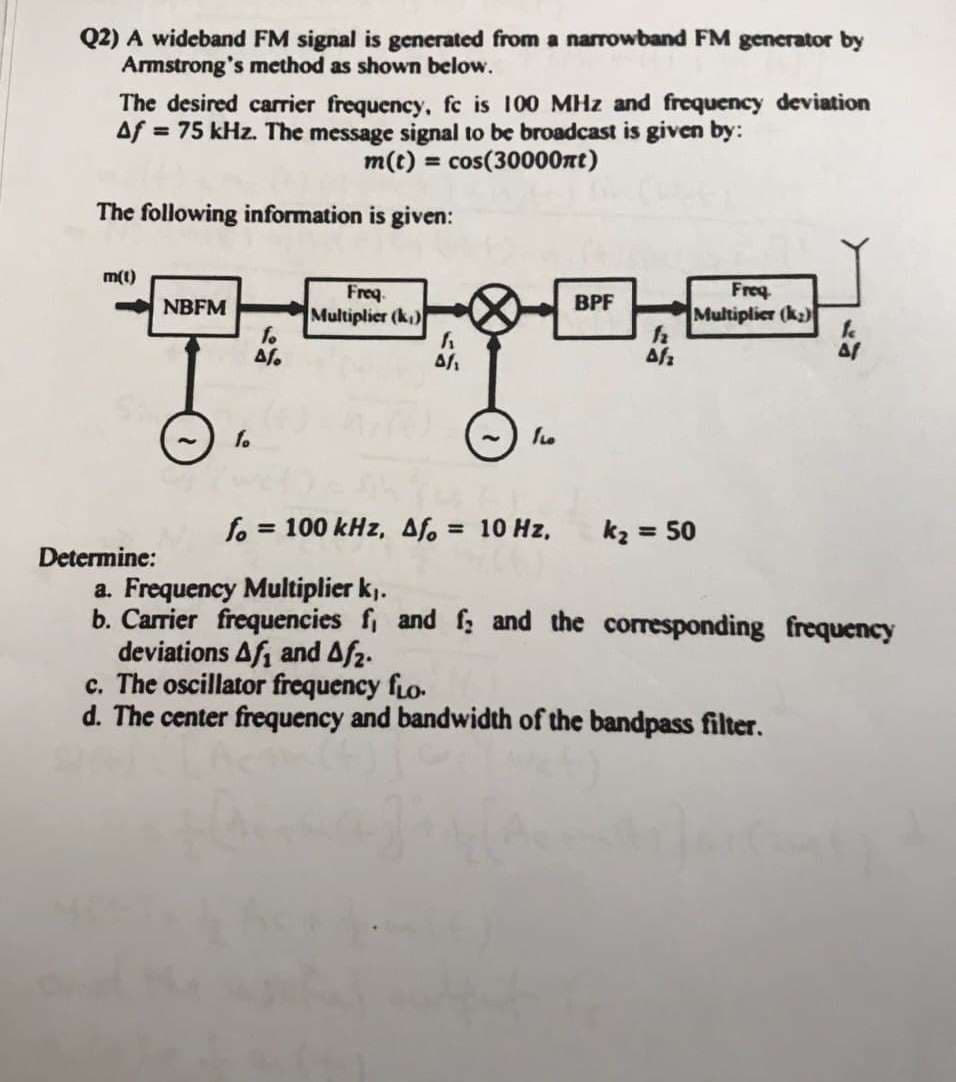Q2) A wideband FM signal is generated from a narrowband FM generator by Armstrong's method as shown below. The desired carrier frequency, fc is 100 MHz and frequency deviation Af = 75 kHz. The message signal to be broadcast is given by: m(t) = cos(30000nt) The following information is given: m(1) Freq Multiplier (k2) Freq. NBFM BPF Multiplier (k) fo af fo fo = 100 kHz, Afo = 10 Hz, kz = 50 %3D Determine: a. Frequency Multiplier k,. b. Carrier frequencies f, deviations Af and Af2. c. The oscillator frequency fLo. d. The center frequency and bandwidth of the bandpass filter. and f; and the corresponding frequency
Q2) A wideband FM signal is generated from a narrowband FM generator by Armstrong's method as shown below. The desired carrier frequency, fc is 100 MHz and frequency deviation Af = 75 kHz. The message signal to be broadcast is given by: m(t) = cos(30000nt) The following information is given: m(1) Freq Multiplier (k2) Freq. NBFM BPF Multiplier (k) fo af fo fo = 100 kHz, Afo = 10 Hz, kz = 50 %3D Determine: a. Frequency Multiplier k,. b. Carrier frequencies f, deviations Af and Af2. c. The oscillator frequency fLo. d. The center frequency and bandwidth of the bandpass filter. and f; and the corresponding frequency
Introductory Circuit Analysis (13th Edition)
13th Edition
ISBN:9780133923605
Author:Robert L. Boylestad
Publisher:Robert L. Boylestad
Chapter1: Introduction
Section: Chapter Questions
Problem 1P: Visit your local library (at school or home) and describe the extent to which it provides literature...
Related questions
Question

Transcribed Image Text:Q2) A wideband FM signal is generated from a narrowband FM generator by
Armstrong's method as shown below.
The desired carrier frequency, fc is 100 MHz and frequency deviation
Af = 75 kHz. The message signal to be broadcast is given by:
m(t) = cos(30000nt)
%3D
The following information is given:
m(t)
Freq.
Multiplier (k)
fo
Freq
Multiplier (k2)
NBFM
BPF
fo
fo = 100 kHz, afo = 10 Hz,
kz = 50
%3D
%3D
Determine:
a. Frequency Multiplier k).
b. Carrier frequencies fi and f and the corresponding frequency
deviations Af, and Af2.
c. The oscillator frequency fLo-
d. The center frequency and bandwidth of the bandpass filter.
Expert Solution
This question has been solved!
Explore an expertly crafted, step-by-step solution for a thorough understanding of key concepts.
Step by step
Solved in 2 steps with 1 images

Knowledge Booster
Learn more about
Need a deep-dive on the concept behind this application? Look no further. Learn more about this topic, electrical-engineering and related others by exploring similar questions and additional content below.Recommended textbooks for you

Introductory Circuit Analysis (13th Edition)
Electrical Engineering
ISBN:
9780133923605
Author:
Robert L. Boylestad
Publisher:
PEARSON

Delmar's Standard Textbook Of Electricity
Electrical Engineering
ISBN:
9781337900348
Author:
Stephen L. Herman
Publisher:
Cengage Learning

Programmable Logic Controllers
Electrical Engineering
ISBN:
9780073373843
Author:
Frank D. Petruzella
Publisher:
McGraw-Hill Education

Introductory Circuit Analysis (13th Edition)
Electrical Engineering
ISBN:
9780133923605
Author:
Robert L. Boylestad
Publisher:
PEARSON

Delmar's Standard Textbook Of Electricity
Electrical Engineering
ISBN:
9781337900348
Author:
Stephen L. Herman
Publisher:
Cengage Learning

Programmable Logic Controllers
Electrical Engineering
ISBN:
9780073373843
Author:
Frank D. Petruzella
Publisher:
McGraw-Hill Education

Fundamentals of Electric Circuits
Electrical Engineering
ISBN:
9780078028229
Author:
Charles K Alexander, Matthew Sadiku
Publisher:
McGraw-Hill Education

Electric Circuits. (11th Edition)
Electrical Engineering
ISBN:
9780134746968
Author:
James W. Nilsson, Susan Riedel
Publisher:
PEARSON

Engineering Electromagnetics
Electrical Engineering
ISBN:
9780078028151
Author:
Hayt, William H. (william Hart), Jr, BUCK, John A.
Publisher:
Mcgraw-hill Education,